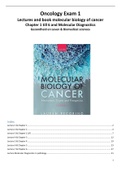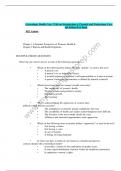Oncology Exam 1
Lectures and book molecular biology of cancer
Chapter 1 till 6 and Molecular Diagnostics
Gezondheid en Leven & Biomedical sciences
Index
Lecture 1 & Chapter 1 ....................................................................................................................................................... 2
Lecture 2 & Chapter 2 ....................................................................................................................................................... 4
Lecture 3 & Chapter 2.3/5 ................................................................................................................................................ 7
Lecture 4 & Chapter 3 ..................................................................................................................................................... 12
Lecture 5 & Chapter 4 ..................................................................................................................................................... 19
Lecture 6 & Chapter 5 ..................................................................................................................................................... 23
Lecture 7 & Chapter 6 ..................................................................................................................................................... 27
Lecture Molecular Diagnostics in pathology ................................................................................................................... 31
1
,Lecture 1 & Chapter 1
Chapter 1 – the nature of cancer
Incidence: the number of new cases registered within a certain period. NL: 124.000 patients, 1/137.
Prevalence: all persons who, somewhere in time, have been diagnosed with cancer, and are still living at a certain
date. NL: 380.000 in 5-year cancer prevalence
Mortality: number of patients who died as result of cancer within a period. NL: Around 46.000, no rising trend which
means that we are getting better in treatment.
Survival: percentage of patients still alive after having the cancer diagnosis, corrected for the
expected death within normal situations. NL: Survival increases, due to prompt treatment
Cancer mortality trends (in %)
We can see a decrease in the total mortality, but there are major differences between the
different types of cancer. For example, in lung cancer: men mortality decreases and women
increases, this is due to an increase in smoking under women.
What is cancer?
Cancer is a name for a group of diseases and there are more than 100 cancer types distinguished. A tumor does not
always mean that a patient has cancer, a tumor is a mass of cells and only when these cells are invasive and have
metastasis, we can call it cancer. A malignant tumor is life threatening because they use up a lot of nutrients and
energy, the invasion can give organ disturbs etc. A malignant tumor is invasive, a benign tumor is not.
Differences between types of cancer
- Carcinomas are tumors out of epithelial cells = 85%
- Adenocarcinomas are tumors out of glandular tissue
- Sarcomas form out of mesoderm tissue (= bone, muscle)
- Lymphomas: are (progenitor) white blood cells.
Development of cancer = oncogenesis
Carcinogens are mutagens; agents causing cancer, due to alterations in
the DNA which causes a stepwise development of cancer. DNA of tumor
cells can have subtle point mutations up to large chromosomal mutations
like translocations. All cells in a primary tumor are clonal (= starts from
one cell, so every cell has the same mutations) due to the accumulation
of mutations in the daughter cells of a developed tumor these cells
become heterogeneous. Cancer in definition is not inheritable, almost all
of the mutations develop in somatic cells and will not be passed to the next generation of offspring. However, some
inherited germline mutations can increase the chance to develop cancer and can be passed on to the next
generation. These mutations are rarely involved in causing cancer immediately. Thereby, inheritable somatic
modifications of the genome and chromatin structure, called epigenetics, also play a role in carcinogenesis. Cancer is
an older people disease due to the accumulation of DNA mutations; the older we get, the more DNA mutations we
get and the more prone we are for developing cancer.
10 characteristics of cancer
A tumor is more than just tumor cells, it contains cells like fibroblast, vessels, immune cells etc. A tumor cell is a less
differentiated cell that can proliferate endless and has a blockage in cell death and in differentiation pathways.
Oncogenes drive cancer formation, and tumor suppressor genes block this formation, in normal health cells. The
established hallmarks and emerging hallmarks of cancer are: growth signal autonomy, evasion of growth inhibitory
signals, avoiding immune destruction, unlimited replicative potential, tumor-promoting inflammation, invasion and
metastasis, angiogenesis, genome instability, evasion of cell death and reprogramming energy metabolism.
Distinguishing cancer cells from normal cells in culture
Cancer cells have different morphology; they adopt a round morphology rather than a flat and extended one, can
grow in low serum culture media, show no/decreased contact inhibition and can grow without substrate for
2
,attachment. Oncogenes can be identified by isolation of the gene from tumor cells, which DNA is transfected into
immortalized primary cells complemented with an evaluation (by a transformation assay) whether these transfected
cells obtain altered growth characteristics.
Factors playing a role in development of cancer
These are genetic, environmental and metabolic factors
Some can be influenced like: environment, diet, alcohol, smoking, viruses, contraception, UV-light, reproductive life
etc. Of course, there are also factors which cannot be chanced like: our metabolism pathways, reproduction
pathways, menopause, errors in DNA replication etc.
Growth, apoptosis and differentiation regulate cell numbers
These factors contribute to the overall net cell number in an individual. DNA
mutations that alter the function of normal genes involved in growth, apoptosis or
differentiation can affect the balance of cell numbers in the body and lead to
unregulated growth. Blocking differentiation of stem cells is a cause of leukemias.
Growth is regulated by both positive and negative molecular factors encoded by
genes and every body cell contains 2 alleles of each gene. When a normal growth
gene, called a proto-oncogene, is mutated it turns into an oncogene. This is a dominant process, which means that
only one allele has to be mutated in order to make an oncogene. Tumor suppressor genes are genes encoding for
proteins which can stop the cell cycle, in order to block a tumor suppressor gene both
alleles need to be mutated, this is a recessive process.
Treatment of cancer
- Surgery: very often not possible
- Radiotherapy & chemotherapy: These treatments are to prevent proliferation (=
cytostatic effects) and to kill the cancer cells (= cytotoxic effects).
There are also always side effects, the therapeutic index is the difference between adverse
events and toxicity on normal tissues, this difference should be as large as possible. The
therapeutic window is the difference between the maximum tolerated dose (MTD) and the
minimum dose needed to exert anti-cancer activity, this should also be as high as possible.
Nevertheless, the index and window of most chemotherapeutics are relatively small.
The aim of targeted drugs is the development of novel anti-cancer agents with selective
activity against cancer cells, thus causing less toxicity. Every hallmark is a potential target for selective therapy and
this is tested via clinical trials: phase 1 checks the safety, phase 2 checks the efficacy and phase 3 tests the efficacy
against conventional treatments via RCTs.
Cancer genomics
This is the study of the totality of DNA sequences and gene expression differences between tumor cells and normal
host cells. Genomics has shown that every tumor has its own unique genetic profile, different patients therefore
need different treatments, this is called targeted therapy or personalized medicine. It is a task to define and select
the right patients to treat. For this, patients should be selected on diagnostics, genetics, imaging and
immunohistochemistry. Molecules of interest in these treatments are kinases, which play a critical role in major cell
functions, including signal transduction and transcription. Next-generation sequencing can examine the sequences
quickly. The completion of the Human Genome Project paved the way for genomics. After that, new high-throughput
sequencing technologies, such as next-generation sequencing have been developed. Single nucleotide
polymorphisms (SNPs) are being identified and linked to different types of cancer. Genome-wide association studies
(GWAS) can investigate the whole genome for common genetic variants in many different individuals to see the
association with cancer and the possible targeted therapies.
3
, Lecture 2 & Chapter 2
Chapter 2 – DNA structure and stability: mutations vs repair
Recap gene structure
A nucleotide is made up of sugar, phosphate and a nitrogenous base (adenine,
guanine, cytosine or thymine), these are purines or pyrimidines, see picture
below. The 5’ end of the gene makes up the promotor region, which regulates
expression. The TATA box (TATAAAA), near the start of transcription, is one of the
most important regulatory elements for most genes. Binding of the TATA box-
binding protein (TBP) to the TATA box is crucial for the initiation of transcription.
A short sequence of DNA within the promotor, that is recognized by a specific
protein and contributed to the regulation of the gene, is called a response
element (RE). From the 5’ till 3’ end exons and introns are found and read down-
stream. DNA is being transcribed into RNA and RNA is being translated into protein. Different proteins can be
translated due to splicing and posttranslational modifications.
DNA and cancer
DNA mutations have effect on the conformation of proteins and thereby effect the property of proteins. Small
localized areas of hypermutations in genes are called kataegis thereby chromothropsis is a process by which
chromosomes are shattered, resulting in ten to hundreds genomic rearrangements. Tumor cells also contain large
circular extrachromosomal DNAs these genes can replicate but are not equally segregated to daughter cells, this
leads to extreme copy number amplification and this contributes to tumor cell heterogeneity. Driver mutations are
located in cancer genes and offer a growth advantage to cells, whereas passenger mutations do not. 5-7 driver
mutations are required in most cancers. Mutations in the promotor regions have the biggest effect on gene
transcription, this can lead to over- or under expression.
Different kinds of genes
- Stability genes: DNA repair genes, which can be inactivated. This leads to genetic instability, an enabling
characteristic of cancer.
- Oncogenes: like growth factors, which can be activated
- Tumor suppressor genes, which can be inactivated.
Changes in the DNA
Small: base pair substitutions, small deletions or insertions and single- and double-
strand breaks.
➔ Transition: substitution of one purine for another purine
➔ Transversion: substitution of a purine for a pyrimidine or vice versa.
Large: changes in DNA content per nucleus, chromosome rearrangements (= checked
by chromosome painting, spectral karyotyping), gene amplifications or deletions.
➔ Gene amplification: the copy number of a gene increases from the two copies
present in the normal diploid genome.
Causes of DNA aberrations:
Specific mutational processes can produce a pattern of mutations known as mutational signatures. The codon
position of somatic mutations can be tumor-type and carcinogen-type specific. Different agents have their own
mutation spectrum. Exogenous mutations are caused by smoking, polycyclic aromatic hydrocarbons, alcohol, UV-
light and radiation. Endogenous mutations are caused by DNA replication mistakes (= DNA polymerase is not always
100% accurate), reactive oxygen species (ROS) (= oxidative phosphorylation in the mitochondria produces ROS),
hormone initiators or covalent additions and alterations of the chromatin structure which can cause misreading of
the DNA template.
4







